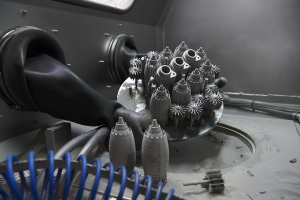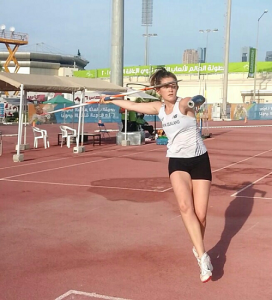Inside GE Additive’s Arcam EBM Centre of Excellence, Gothenburg with CEO Jason Oliver
HRE Wheels and GE Additive showcase next generation metal 3D printed on a 2019 Ford GT
Kiwi Companies Partner to Build Tailored 3D Printed Training Prosthetics for Female Para-Athletes
New Zealand-based Zenith Tecnica, which is the only company in the country using Electron Beam Melting (EBM) technology to make 3D printed titanium components, is teaming up with High Performance Sports NZ (HPSNZ) to give two inspiring Kiwi athletes a competitive edge for the Tokyo 2020 Paralympics. Through this collaboration, the two companies will produce tailored 3D printed prosthetics for esteemed para-athletes Anna Grimaldi and Holly Robinson to use while working out and training in the gym.
3D printing has been used multiple times to help disabled athletes get a leg up over their competition, with prosthetics and braces as some of the main applications. As Zenith Tecnica, headquartered in Auckland, has supplied EBM 3D printed titanium components to America’s Cup Regatta and Formula 1 teams, fabricated plenty of medical instruments and implants, and manufactured components in outer space, the company was more than up to the challenge of making advanced, tailored prosthetics for Grimaldi and Robinson.
“Zenith Tecnica 3D printed the new attachment for Holly and Anna to use in the gym,” said Dr Stafford Murray, HPSNZ Head of Innovation. “It’s providing them with something different that you can’t buy off the shelf, that enables them to be the best that they can be.”
The company utilizes the Arcam Q10 plus and Q20 plus systems to produce EBM parts for multiple industries. These 3D printers are built on breakthrough deflection electronics, which allow for extremely accurate, fast beam control so melting can occur simultaneously at more than one point, while still maintaining excellent speed, precision, and surface finish. In addition, its hot vacuum process means no residual stresses to distort the 3D printed components.
“Zenith Tecnica offers a freedom of design to a lot of engineers, so we are not constrained to classical manufacturing methods like machining and casting,” explained Peter Sefont, the Production Manager at Zenith Tecnica. “It allows us and the engineers to do whatever we want.”
HPSNZ is a leader in sports innovation, and works with National Sporting Organisations (NSOs) to identify athletes’ strengths and push them further with modern technology and sports science. By partnering with Zenith Tecnica and using its EBM titanium 3D printing expertise, the company is able to think about the possibilities of design in a new way and knock down any boundaries that would otherwise limit them.
“To have someone listen to what we need and be like, ‘Nothing is off the table, we can try and build whatever it is you need,’ that was really awesome,” Grimaldi said about the teamwork between HPSNZ and Zenith Tecnica.
These two fierce female para-athletes are simply amazing. Robinson won the silver medal in the Women’s Javelin F46 at both the Rio 2016 Paralympics and the 2018 Gold Coast Commonwealth Games. She’s already thrown her personal best – 45.73 m – which was good enough to break the world record in the event at the Australian Track & Field Championships in Sydney this past weekend.
Grimaldi won the gold in the Women’s Long Jump T47 at the Rio 2016 Paralympics and came in fourth in the Women’s 100m T47 at the same competition. This coming June, both women will have an optimal opportunity to see if their new 3D printed training prosthetics can help them win at the 2019 Oceania Area and Combined Events Championships.
Raylene Bates, Athletics New Zealand high performance coach, said, “This is a piece of equipment that would enable them to train like an able-bodied person; granting the use of both arms with a full range of movement, achieving a full body balance.”
Of course, all of these competitions are a precursor to the main event both Robinson and Grimaldi are working towards – the 2020 Paralympics in Tokyo. The hope is that through this partnership between Zenith Tecnica and HPSNZ, their new 3D printed titanium prosthetics will help them up their game while preparing for next year’s competition. Because these will be prosthetics tailored specifically to them, exercises and training methods that the para-athletes were previously unable to do because of previous off-the-shelf prosthetics should now be entirely possible…which means that gold medals are possible as well.
Discuss this inspiring story, and other 3D printing topics, at 3DPrintBoard.com or share your thoughts in the Facebook comments below.
GH Induction Group Announces New Service for 3D Printed Copper Coils & Inductors
 While the substantial benefits of 3D printing are discussed often in the progressive industrial and technological sectors today, the advantages they can have for just one business and their innovative endeavors are enormous. For a company like GH Induction Group, being able to 3D print with copper allows the Valencia, Spain-headquartered induction heating company to offer improved solutions for over 4,000 customers around the globe—many of whom may benefit from electromagnetic induction heating based on new production processes in electron beam melting (EBM).
While the substantial benefits of 3D printing are discussed often in the progressive industrial and technological sectors today, the advantages they can have for just one business and their innovative endeavors are enormous. For a company like GH Induction Group, being able to 3D print with copper allows the Valencia, Spain-headquartered induction heating company to offer improved solutions for over 4,000 customers around the globe—many of whom may benefit from electromagnetic induction heating based on new production processes in electron beam melting (EBM).
Now, GH Induction Group is launching 3Dinductors, their new website (http://www.3dinductors.com) completely dedicated to their 3D printed coils and inductors, made of pure copper. While copper is a metal that offers a list of almost magical benefits due to its malleable texture and excellent ductility, accompanied by 3D printing technology, GH can produce inductors with a significantly increased service life (up to four times higher in some cases), higher density, and stronger mechanical properties. Coil spares are manufactured to be identical geometrically, and all parts are optimized for the high performance.
“This means reduced production costs per part and an improvement in treatment that cannot be achieved with current technology,” states the GE team in their most recent press release.
Critical attention to research and design, and ongoing development—as well as experimenting with other 3D printing processes that could not deliver like EBM does—has allowed GH to make serious breakthroughs for industrial companies engaged in manufacturing processes that require industrial induction heating technology. Applications such as automotive are a perfect example of industries that will benefit further from such techniques as part production cost is significantly reduced, production is much more efficient overall, and less inventory is required.
Although there are many different production methods for 3D printing and additive manufacturing methods today using metal, electron beam melting is the only method allowing GH to print pure copper alloy. To begin, the GH team can engineer their own 3D CAD designs, making changes as needed, and quickly. They are also able to control production and quality, preventing the number of hot spots, improving coil cooling as they transform inductor characteristics when necessary, and manufacture in a vacuum atmosphere to prevent porosity issues and rusting. 3D printed inductors can also be fixed just like conventionally-manufactured designs.
3D printing with metal has become popular for a wide range of industries because it offers the ability to manufacture extremely strong but lightweight parts with complex geometries. We have seen numerous other forays into 3D printing with copper too, as researchers create pure copper powder, construction engineers design 3D printed copper roofs, and others are dedicated to improving processes using this metal and others. What do you think of this news? Let us know your thoughts; join the discussion of this and other 3D printing topics at 3DPrintBoard.com.
[Source / Images: GH Induction Group]







